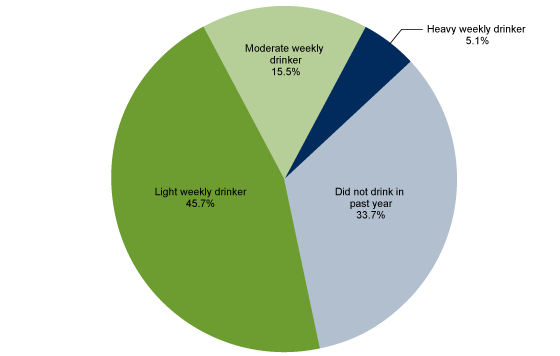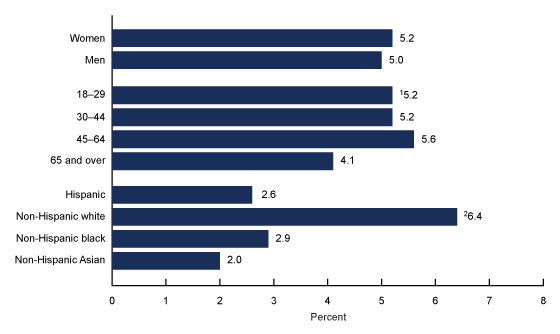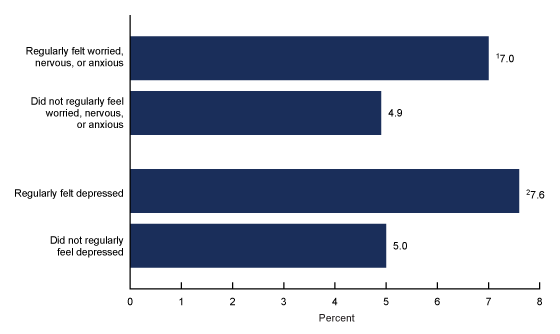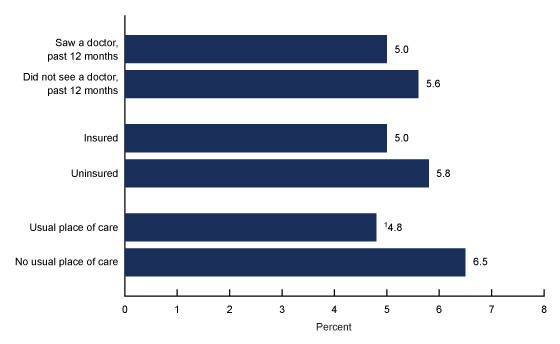Heavy Drinking Among U.S. Adults, 2018
- Key findings
- In 2018, two-thirds of adults aged 18 and over consumed alcohol in the past year.
- The percentage of adults who engaged in heavy drinking in the past year varied by age, Hispanic origin, and race.
- The percentage of adults who engaged in heavy drinking in the past year varied by select mental health indicators.
- The percentage of adults who engaged in heavy drinking in the past year varied little across select measures of health care access and utilization.
- Summary
- Definitions
- Data source and methods
- About the authors
- References
- Suggested citation
PDF Version (403 KB) | Visual Abstract
Key findings
Data from the National Health Interview Survey
- In 2018, two-thirds (66.3%) of adults aged 18 and over consumed alcohol in the past year.
- Among adults aged 18 and over, 5.1% engaged in heavy drinking (consumption of an average of more than 14 alcoholic drinks per week for men or more than 7 drinks per week for women in the past year).
- Non-Hispanic white adults (6.4%) were more likely than non-Hispanic black (2.9%), Hispanic (2.6%), and non-Hispanic Asian (2.0%) adults to engage in heavy drinking.
- Adults who regularly felt worried, nervous, or anxious, or who regularly felt depressed, were more likely than adults without these feelings to engage in heavy drinking in the past year.
- Adults who saw a doctor in the past year were as likely as adults who did not see a doctor to engage in heavy drinking.
Heavy drinking is defined as the average consumption of more than 7 drinks per week for women and more than 14 drinks per week for men in the past year (1). Heavy drinking is associated with an increased risk of alcohol use disorders, suicide, interpersonal violence, traffic injuries, liver disease, certain cancers and infectious diseases, and adverse birth outcomes in pregnant women (1,2). This report describes adult alcohol use in the United States and presents the prevalence of heavy drinking by demographic characteristics, select mental health indicators, and select measures of health care access and utilization.
Keywords: alcohol use, health care access and utilization, mental health, National Health Interview Survey
In 2018, two-thirds of adults aged 18 and over consumed alcohol in the past year.
In 2018, 5.1% of adults engaged in heavy drinking in the past year, 15.5% engaged in moderate drinking, 45.7% engaged in light drinking, and 33.7% did not consume alcohol (Figure 1).
Figure 1. Percent distribution of current alcohol drinking status among adults: United States, 2018
NOTES: An adult who engaged in light drinking averaged three or fewer drinks per week in the past year. An adult who engaged in moderate drinking averaged 4 to 14 drinks per week for men and 4 to 7 drinks per week for women in the past year. An adult who engaged in heavy drinking averaged more than 14 drinks per week for men and more than 7 drinks per week for women in the past year. Estimates are based on household interview of a sample of the civilian noninstitutionalized population. Access data table for Figure 1.
SOURCE: National Center for Health Statistics, National Health Interview Survey, 2018.
The percentage of adults who engaged in heavy drinking in the past year varied by age, Hispanic origin, and race.
- Men (5.0%) were as likely as women (5.2%) to engage in heavy drinking in the past year (Figure 2).
- The percentage of adults who engaged in heavy drinking was lowest among adults aged 65 and over (4.1%).
- Non-Hispanic white adults (6.4%) were more likely than non-Hispanic black (2.9%), Hispanic (2.6%), and non-Hispanic Asian (2.0%) adults to engage in heavy drinking.
Figure 2. Percentage of adults who engaged in heavy drinking in the past year, by select demographic characteristics: United States, 2018
1Significant quadratic trend by age group (p < 0.05).
2Significantly different from Hispanic, non-Hispanic black, and non-Hispanic Asian adults (p < 0.05).
NOTES: Heavy drinking is the average consumption of more than 7 drinks per week for women and more than 14 drinks per week for men in the past year. Estimates are based on household interview of a sample of the civilian noninstitutionalized population. Access data table for Figure 2.
SOURCE: National Center for Health Statistics, National Health and Nutrition Examination Survey, 2015–2018.
The percentage of adults who engaged in heavy drinking in the past year varied by select mental health indicators.
Adults who regularly felt worried, nervous, or anxious (7.0%) and adults who regularly felt depressed (7.6%) were more likely than adults without these feelings to engage in heavy drinking in the past year (Figure 3).
Figure 3. Percentage of adults who engaged in heavy drinking in the past year, by select mental health indicators: United States, 2018
1Significantly different from adults who did not regularly feel worried, nervous, or anxious (p < 0.05).
2Significantly different from adults who did not regularly feel depressed (p < 0.05).
NOTES: Heavy drinking is the average consumption of more than 7 drinks per week for women and more than 14 drinks per week for men in the past year. Estimates are based on household interview of a sample of the civilian noninstitutionalized population. Access data table for Figure 3.
SOURCE: National Center for Health Statistics, National Health Interview Survey, 2018.
The percentage of adults who engaged in heavy drinking in the past year varied little across select measures of health care access and utilization.
- The percentage of adults who engaged in heavy drinking was lower, but not significantly different from, those who were insured (5.0%) or saw a doctor in the past year (5.0%), compared with those who were uninsured or did not see a doctor in the past year (5.8% and 5.6%, respectively) (Figure 4).
- Adults without a usual place of care (6.5%) were more likely than adults with a usual place of care (4.8%) to engage in heavy drinking.
Figure 4. Percentage of adults who engaged in heavy drinking in the past year, by select measures of health care access and utilization characteristics: United States, 2018
1Significantly different from adults who do not have a usual place of care (p < 0.05).
NOTES: Heavy drinking is the average consumption of more than 7 drinks per week for women and more than 14 drinks per week for men in the past year. Estimates are based on household interview of a sample of the civilian noninstitutionalized population. Access data table for Figure 4.
SOURCE: National Center for Health Statistics, National Health Interview Survey, 2018.
Summary
During 2018, 1 in 20 adults (5.1%) aged 18 and over engaged in heavy drinking. Heavy drinking was lowest among adults aged 65 and over compared with adults of other ages and highest among non-Hispanic white adults compared with non-Hispanic black, non-Hispanic Asian, and Hispanic adults.
The U.S. Preventive Service Task Force recommends screening adults for unhealthy alcohol use in primary care settings and providing brief behavioral counseling to those whose drinking exceeds certain weekly, daily, or per-occasion amounts (3). These results show that adults who visited a doctor or health care professional in the past year were as likely as those who had not visited any of these clinical settings to engage in heavy drinking. In addition, there was no association between heavy drinking and current health insurance status. However, adults who have a usual place of care were less likely to engage in heavy drinking than adults without a usual place of care. Adults who regularly felt depressed or anxious were more likely to engage in heavy drinking than those without these feelings.
Definitions
Doctor visit in the past 12 months: Based on combined responses of “6 months or less” and “more than 6 months, but not more than 1 year ago” to the survey question, “About how long has it been since you last saw or talked to a doctor or other health care professional about your own health? Include doctors seen while a patient in a hospital.”
Heavy drinking: Defined as averaging more than 14 drinks per week in the past year for men and more than 7 drinks per week for women. This was based on responses to the following questions asked to sample adults who previously reported having had at least 12 in any 1 year or in their entire life: 1) “In the past year, how often did you drink any type of alcoholic beverage?” and 2) “In the past year, on those days that you drank alcoholic beverages, on the average, how many drinks did you have?” Alcohol-use questions begin with the prompt, “Included are liquor such as whiskey or gin, beer, wine, wine coolers, and any other type of alcoholic beverage.” The National Health Interview Survey (NHIS) does not ask about serving size. In the United States, a standard drink is defined as 12.0 ounces of beer (5% alcohol), 5.0 ounces of wine (12% alcohol), or 1.5 ounces of liquor (40% alcohol) (3).
Race and Hispanic origin: Based on two separate questions that determine Hispanic or Latino origin and race. Persons of Hispanic or Latino origin may be of any race.
Regularly felt depressed: In separate questions, respondents were asked, “How often do you feel depressed? Would you say daily, weekly, monthly, a few times a year, or never?” and, “Thinking about the last time you felt depressed, how depressed did you feel? Would you say a little, a lot, or somewhere in between?” Respondents who reported feeling depressed either “a lot” or “somewhere in between” daily or feeling “a lot” on a weekly basis were recorded as regularly feeling depressed.
Regularly felt worried, nervous, or anxious: In separate questions, respondents were asked, “How often do you feel worried, nervous, or anxious? Would you say daily, weekly, monthly, a few times a year, or never?” and, “Thinking about the last time you felt worried, nervous, or anxious, how would you describe the level of these feelings? Would you say a little, a lot, or somewhere in between?” Respondents who reported feeling worried, nervous, or anxious either “a lot” or “somewhere in between” daily or feeling “a lot” on a weekly basis were recorded as regularly feeling worried, nervous, or anxious.
Uninsured: A person was defined as uninsured if he or she did not have any private health insurance, Medicare, Medicaid, Children’s Health Insurance Program, state-sponsored or other government-sponsored health plan, or military plan at the time of the interview. A person was also defined as uninsured if he or she had only Indian Health Service coverage or had only a private plan that paid for one type of service, such as accidents or dental care.
Usual place of care: Based on a positive response to the survey question, “Is there a place that you usually go to when you are sick or need advice about your health?” Adults whose usual place of care was the hospital emergency room were considered not to have a usual place of care.
Data source and methods
Data from the 2018 NHIS were used for this analysis. NHIS is a nationally representative household survey of the civilian noninstitutionalized U.S. population. It is conducted continuously throughout the year by the National Center for Health Statistics (NCHS). Interviews are conducted in respondents’ homes, but follow-ups to complete interviews may be conducted over the telephone. For more information about NHIS, visit https://www.cdc.gov/nchs/nhis.htm.
The NHIS sample design is described in more detail elsewhere (4). Point estimates and the corresponding variances for this analysis were calculated using SUDAAN software (5) to account for the complex sample design of NHIS. Tests for quadratic trends by age were evaluated using orthogonal polynomials. Differences between percentages were evaluated using two-sided significance tests at the 0.05 level. All estimates met NCHS data presentation standards (6).
About the authors
Peter Boersma, Maria A. Villarroel, and Anjel Vahratian are with the National Center for Health Statistics, Division of Health Interview Statistics.
References
- Centers for Disease Control and Prevention. Excessive alcohol use.
- World Health Organization. Global status report on alcohol and health 2018. Geneva, Switzerland. 2018.
- U.S. Preventive Services Task Force. Screening and behavioral counseling interventions to reduce unhealthy alcohol use in adolescents and adults: U.S. Preventive Services Task Force Recommendation Statement. JAMA320(18):1899–1909. 2018.
- National Center for Health Statistics. Survey description, National Health Interview Survey, 2018. Hyattsville, Maryland. 2019.
- RTI International. SUDAAN (Release 11.0.01) [computer software]. 2013..
- Parker JD, Talih M, Malec DJ, Beresovsky V, Carroll M, Gonzalez Jr JF, et. al. National Center for Health Statistics data presentation standards for proportions. National Center for Health Statistics. Vital Health Stat 2(175). 2017.
Suggested citation
Boersma P, Villarroel MA, Vahratian A. Heavy drinking among U.S. adults, 2018. NCHS Data Brief, no 374. Hyattsville, MD: National Center for Health Statistics. 2020.
Copyright information
All material appearing in this report is in the public domain and may be reproduced or copied without permission; citation as to source, however, is appreciated.
National Center for Health Statistics
Brian C. Moyer, Ph.D., Director
Amy M. Branum, Ph.D., Acting Associate Director for Science
Division of Health Interview Statistics
Stephen J. Blumberg, Ph.D., Director
Anjel Vahratian, Ph.D., M.P.H., Associate Director for Science



